
The Cyperaceae are a family of graminoid (grass-like), monocotyledonous flowering plants known as sedges. The family is large; botanists have described some 5,500 known species in about 90 genera – the largest being the "true sedges", with over 2,000 species.

Carex is a vast genus of over 2,000 species of grass-like plants in the family Cyperaceae, commonly known as sedges. Other members of the family Cyperaceae are also called sedges, however those of genus Carex may be called true sedges, and it is the most species-rich genus in the family. The study of Carex is known as caricology.
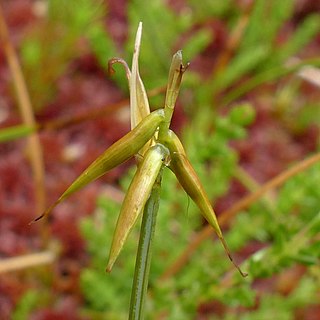
Carex pauciflora, the few-flowered sedge, is a perennial species of sedge in the family Cyperaceae native to bogs and fens in cool temperate, subarctic, and mountainous regions of the Northern Hemisphere. The specific epithet pauciflora refers to the Latin term for 'few flowered'.

Carex comosa is a species of sedge known as longhair sedge and bristly sedge. It is native to North America, where it grows in western and eastern regions of Canada and the United States, and parts of Mexico. It grows in wet places, including meadows and many types of wetlands. Tolerates deeper water than most common species and is good for retention basins. This sedge produces clumps of triangular stems up to 100 or 120 centimeters tall from short rhizomes. The inflorescence is up to 35 centimeters long and has a long bract which is longer than the spikes. It is a cluster of several cylindrical spikes. The scales over the fruits taper into long, thin awns.

Carex lenticularis is a species of sedge known by the common names lakeshore sedge and goosegrass sedge. It is native to much of northern North America, including most all of Canada and the western United States, where it grows in wet habitats.
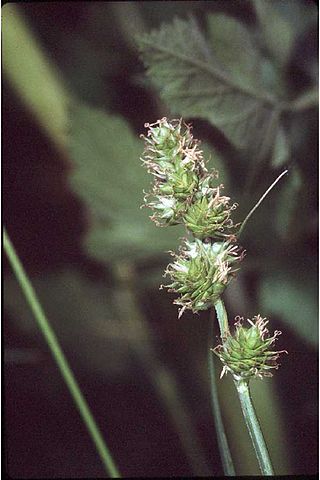
Carex molesta is a species of sedge known by the common name troublesome sedge. It is native to eastern and central North America, where it grows in varied wet and dry habitats, performs equally well in full sun and partial shade, including disturbed areas such as roadsides. It is an introduced species and often a weed in California.
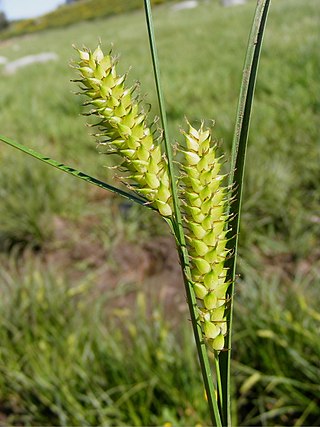
Carex vesicaria is an essentially Holarctic species of sedge known as bladder sedge, inflated sedge, and blister sedge. It has been used to insulate footwear in Norway and among the Sami people, and for basketry in North America.

Carex pensylvanica is a species of flowering plant in the sedge family commonly called Pennsylvania sedge. Other common names include early sedge, common oak sedge, and yellow sedge.
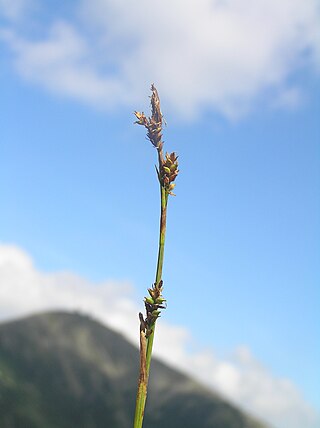
Carex vaginata is a species of sedge known by the common name sheathed sedge.

Carex lacustris, known as lake sedge, is a tufted grass-like perennial of the sedge family (Cyperaceae), native to southern Canada and the northern United States. C. lacustris us an herbaceous surface-piercing plant that grows in water up to 50 cm (1.6 ft) deep, and grows 50–150 cm (1.6–4.9 ft) tall. It grows well in marshes and swampy woods of the boreal forest, along river and lake shores, in ditches, marshes, swamps, and other wetland habitat. It grows on muck, sedge peat, wet sand or silt, in filtered or full sunlight.

Carex eburnea, known as ivory sedge, ebony sedge, and bristleleaf or bristle-leaved sedge, is a small and slender sedge native to North America, from Alaska and Newfoundland south to central Mexico.

Carex exilis, common name coastal sedge or meager sedge, is a species of grass-like plant in the Cyperaceae family. It is native to North America and Canada, with several disjunct populations from southern Canada to the Gulf Coast.

Carex stipata, variously called the prickly sedge, awl-fruited sedge, awlfruit sedge, owlfruit sedge, swamp sedge, sawbeak sedge, stalk-grain sedge and common fox sedge, is a species of flowering plant in the genus Carex, native to Canada, the United States, China, Korea, Japan, and Far Eastern Russia. It is a wetland obligate.

Carex pedunculata, the long-stalk sedge or longstalk sedge, is a species of flowering plant in the genus Carex, native to Canada and the central and eastern United States. Its seeds are dispersed by ants.

Carex muehlenbergii is a species of flowering plant, it is a type of sedge. It is a grass-like plant in the family Cyperaceae. Its common names include sand sedge, Muhlenberg's sedge.
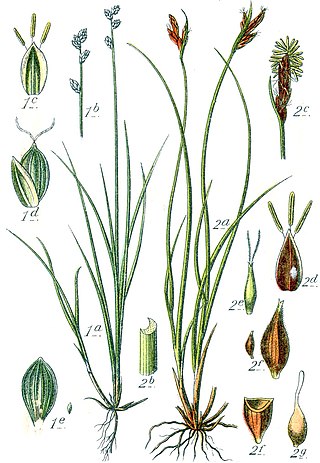
Carex loliacea is a species of flowering plant in the family Cyperaceae.
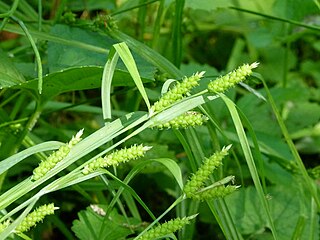
Carex granularis, the limestone meadow sedge, is a widespread species of flowering plant in the family Cyperaceae, native to Canada and the United States east of the Rockies. As its common name suggests, it prefers wet areas and can tolerate alkaline conditions.

Carex retrorsa,, is a widespread species of flowering plant in the family Cyperaceae, native to southern Canada and the northern United States.
Carex xerantica, the dry sedge, dryland sedge, or white-scaled sedge, is a species of flowering plant in the family Cyperaceae, native to western and central Canada, and the north-central United States. It can be found in a wide variety of habitats, including meadows, prairies, open woodlands, bluffs, sandy or rocky areas, and even talus slopes.

Carex grisea, the wood gray sedge or inflated narrow-leaf sedge, is a widespread species of flowering plant in the family Cyperaceae, native to eastern Canada and the central and eastern United States. It resembles and co‑occurs with Carex amphibola in alluvial areas in forests, but where they co‑occur, Carex grisea is usually found in sandier, more alkaline soils.




















